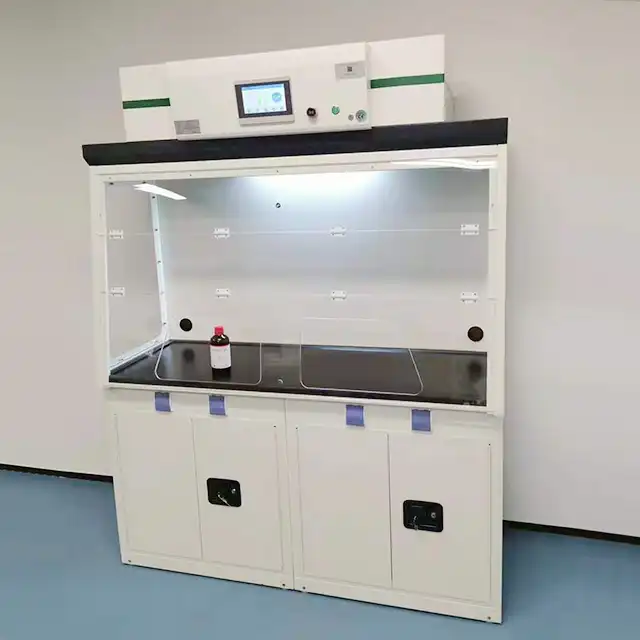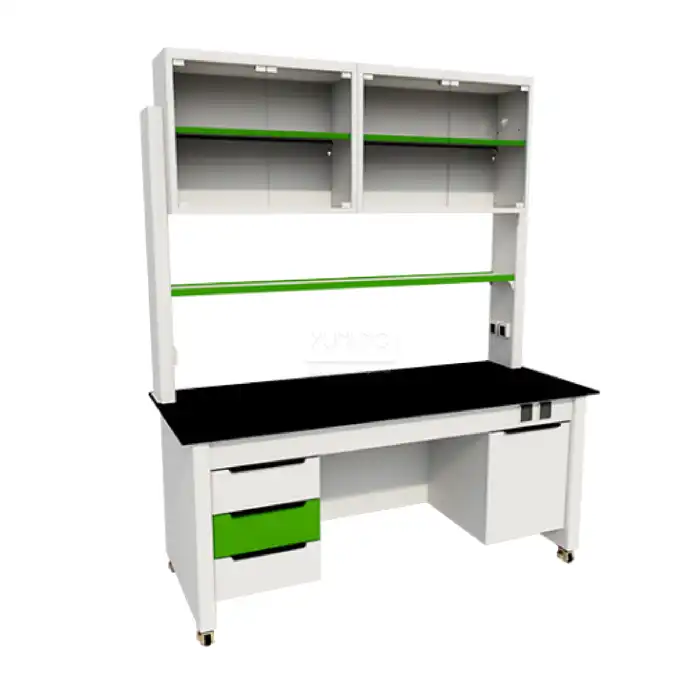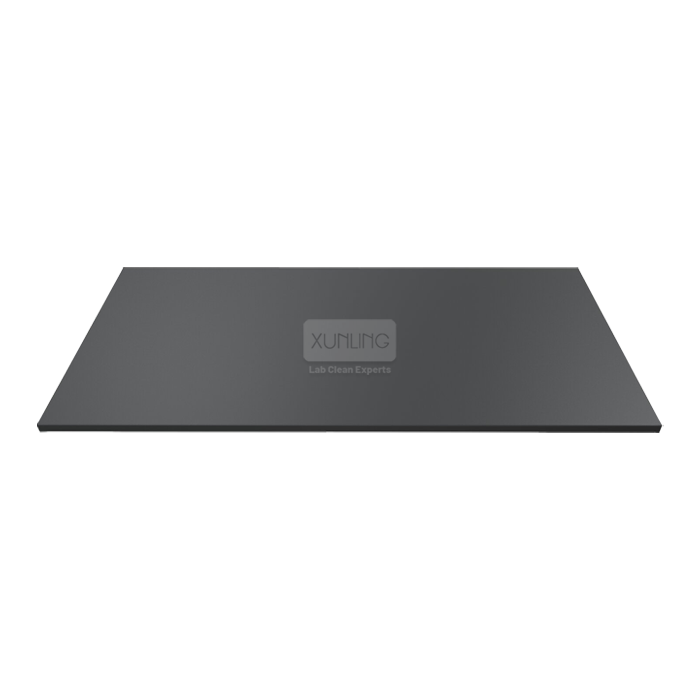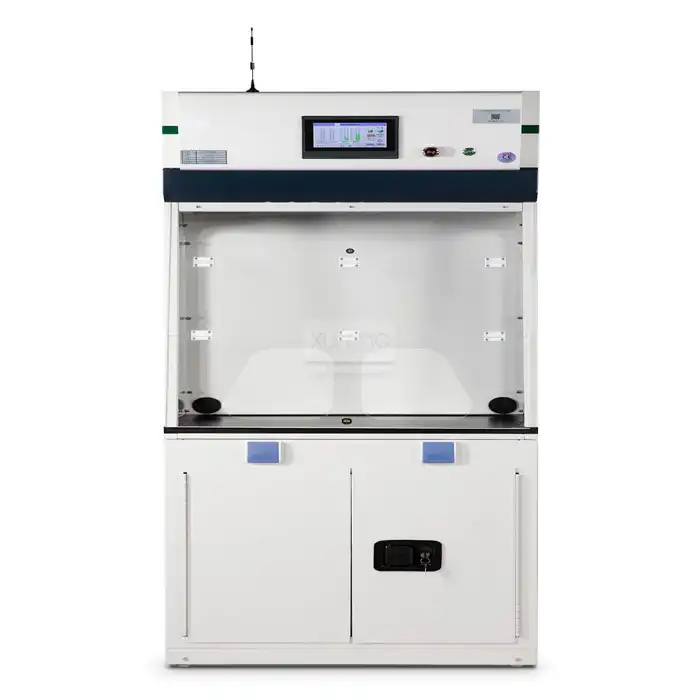
Are SAS Fume Hoods Compatible with Advanced Intelligent Ventilation Systems?
2025-09-15 09:00:03
In today's rapidly evolving laboratory environment, the integration of safety equipment with intelligent control systems has become a critical consideration for laboratory designers and facility managers. The question of whether SAS Fume Hoods can seamlessly integrate with advanced intelligent ventilation systems is particularly relevant as laboratories seek to optimize both safety protocols and energy efficiency. This comprehensive analysis explores the compatibility factors, technical considerations, and practical applications of combining SAS fume hood technology with modern intelligent ventilation control systems. The answer to whether SAS fume hoods are compatible with advanced intelligent ventilation systems is a resounding yes. Modern SAS fume hood designs are specifically engineered to integrate seamlessly with sophisticated ventilation control technologies, including variable air volume (VAV) systems, real-time monitoring networks, and automated response mechanisms. These advanced sas fume hood units incorporate sensor technologies, programmable logic controllers, and communication protocols that enable them to work harmoniously with building management systems and centralized ventilation controls. The compatibility extends beyond basic operational functions to include energy optimization features, predictive maintenance capabilities, and comprehensive safety monitoring systems that enhance overall laboratory performance while maintaining the highest safety standards.
Understanding SAS Fume Hood Technology Integration
Advanced Control Systems in Modern SAS Fume Hoods
Modern SAS fume hood designs represent a significant evolution from traditional ventilation equipment, incorporating sophisticated control systems that enable seamless integration with intelligent building management platforms. These advanced sas fume hood units feature microprocessor-based controllers that can communicate with central building automation systems through various communication protocols, including BACnet, Modbus, and proprietary networking solutions. The control systems within these units are designed to monitor multiple parameters simultaneously, including face velocity, sash position, airflow rates, and containment effectiveness, providing real-time data that can be analyzed and acted upon by intelligent ventilation management systems. The integration capabilities of modern SAS fume hoods extend beyond simple monitoring to include active participation in building-wide energy management strategies. These units can automatically adjust their operational parameters based on occupancy patterns, laboratory schedules, and environmental conditions, working in concert with other building systems to optimize energy consumption while maintaining required safety levels. The sophisticated control algorithms embedded within these sas fume hood systems can predict usage patterns, pre-condition airflow systems, and coordinate with other laboratory equipment to ensure optimal performance across the entire facility. Furthermore, the advanced control systems in modern SAS fume hoods incorporate multiple layers of safety redundancy, including backup sensors, emergency override capabilities, and fail-safe mechanisms that ensure continued safe operation even in the event of communication failures with central control systems. This robust design philosophy ensures that the sas fume hood units maintain their primary safety function while providing the flexibility and intelligence required for integration with advanced building management platforms.
Sensor Technology and Real-Time Monitoring
The sensor technology integrated into contemporary SAS fume hood designs represents a critical component of their compatibility with intelligent ventilation systems. These advanced sas fume hood units incorporate multiple sensor types, including differential pressure sensors, airflow velocity sensors, chemical detection sensors, and occupancy sensors, creating a comprehensive monitoring network that provides detailed operational data to central control systems. The sensors are designed to operate continuously, providing real-time feedback on containment effectiveness, energy consumption, and operational status to both local control systems and building-wide management platforms. The real-time monitoring capabilities of modern SAS fume hoods enable predictive maintenance strategies that can significantly reduce operational costs and improve system reliability. By continuously monitoring key performance indicators such as filter loading, fan performance, and airflow characteristics, these sas fume hood systems can alert facility managers to potential issues before they impact laboratory operations. This proactive approach to maintenance scheduling helps ensure consistent performance while minimizing unexpected downtime and associated costs. Additionally, the comprehensive sensor networks within modern SAS fume hoods provide valuable data for energy optimization algorithms, allowing intelligent ventilation systems to make informed decisions about airflow adjustments, scheduling, and operational modes. The granular data provided by these sensors enables sophisticated control strategies that can balance safety requirements with energy efficiency goals, resulting in significant operational cost savings while maintaining the highest levels of laboratory safety and performance.
Communication Protocols and Network Integration
The successful integration of SAS fume hoods with intelligent ventilation systems depends heavily on robust communication protocols and network infrastructure. Modern sas fume hood designs incorporate multiple communication options, including Ethernet-based networking, wireless communication capabilities, and traditional hardwired connections, ensuring compatibility with diverse building automation architectures. These communication systems are designed to provide reliable, secure data transmission while maintaining the real-time responsiveness required for safety-critical applications. The network integration capabilities of advanced SAS fume hoods extend beyond basic data exchange to include participation in complex control algorithms and decision-making processes. These sas fume hood units can receive commands from central control systems, participate in coordinated responses to emergency situations, and contribute to building-wide optimization strategies. The communication protocols are designed to handle both routine operational data and critical safety information, with appropriate prioritization and redundancy measures to ensure reliable performance under all operating conditions. Moreover, the network integration features of modern SAS fume hoods support advanced analytics and reporting capabilities, enabling facility managers to track performance trends, identify optimization opportunities, and demonstrate compliance with safety regulations. The comprehensive data logging and reporting capabilities of these sas fume hood systems provide valuable insights into laboratory operations, energy consumption patterns, and safety performance metrics that can inform facility management decisions and continuous improvement initiatives.
Benefits of Intelligent Ventilation System Integration
Energy Efficiency and Cost Optimization
The integration of SAS fume hoods with intelligent ventilation systems delivers substantial energy efficiency benefits that translate directly into operational cost savings. Advanced sas fume hood systems equipped with intelligent controls can automatically adjust airflow rates based on actual usage patterns, occupancy levels, and safety requirements, eliminating the energy waste associated with constant maximum airflow operation. These systems can reduce energy consumption by up to 50% compared to traditional constant volume systems while maintaining or improving safety performance through precise control and monitoring capabilities. The cost optimization benefits of intelligent ventilation integration extend beyond direct energy savings to include reduced maintenance costs, extended equipment life, and improved operational efficiency. Modern SAS fume hoods with intelligent controls can optimize their operational parameters to minimize wear on critical components, automatically adjust to changing conditions to prevent premature equipment failure, and provide detailed performance data that enables more effective maintenance scheduling. These sas fume hood systems can also participate in demand response programs, automatically adjusting their operation during peak energy cost periods to help facilities manage their overall energy expenses. Furthermore, the intelligent control capabilities of modern SAS fume hoods enable sophisticated energy management strategies that consider the entire laboratory ecosystem. These systems can coordinate with other laboratory equipment, HVAC systems, and building automation platforms to optimize overall facility energy consumption while maintaining required safety and performance standards. The comprehensive energy monitoring and reporting capabilities of these sas fume hood systems provide facility managers with detailed insights into energy usage patterns, enabling continuous optimization and improvement of operational efficiency.
Enhanced Safety and Compliance Monitoring
The integration of SAS fume hoods with intelligent ventilation systems significantly enhances safety monitoring capabilities and regulatory compliance documentation. Advanced sas fume hood systems with intelligent controls provide continuous monitoring of containment effectiveness, airflow performance, and environmental conditions, automatically alerting facility managers to any deviations from established safety parameters. These systems can detect and respond to potential safety issues faster than traditional monitoring methods, providing early warning of equipment malfunctions, containment failures, or other safety concerns. The comprehensive monitoring and documentation capabilities of intelligent SAS fume hood systems greatly simplify regulatory compliance efforts by automatically generating detailed performance reports, maintenance records, and safety verification data. These sas fume hood systems can track and document compliance with various safety standards, including ASHRAE, OSHA, and other relevant regulations, providing facility managers with the detailed documentation required for regulatory inspections and audits. The automated reporting capabilities ensure consistent, accurate documentation while reducing the administrative burden on laboratory staff. Additionally, the intelligent safety monitoring features of modern SAS fume hoods can integrate with emergency response systems, automatically triggering appropriate responses in the event of containment failures, chemical spills, or other safety incidents. These sas fume hood systems can coordinate with building fire suppression systems, emergency ventilation modes, and notification systems to ensure rapid, coordinated responses to safety emergencies. The integration with intelligent building systems enables more sophisticated emergency response strategies that can help minimize the impact of safety incidents on laboratory operations and personnel.
Predictive Maintenance and System Optimization
The intelligent control capabilities of modern SAS fume hoods enable sophisticated predictive maintenance strategies that can significantly improve system reliability and reduce operational costs. Advanced sas fume hood systems continuously monitor key performance indicators such as filter differential pressure, fan performance characteristics, and airflow patterns, using this data to predict when maintenance will be required and optimize maintenance scheduling. This predictive approach helps prevent unexpected equipment failures while minimizing maintenance costs and downtime. The system optimization capabilities of intelligent SAS fume hoods extend beyond maintenance scheduling to include continuous performance tuning and efficiency improvements. These sas fume hood systems can automatically adjust their operational parameters based on changing conditions, usage patterns, and performance feedback, ensuring optimal performance under all operating conditions. The intelligent control algorithms can identify and implement optimization opportunities that might not be apparent to human operators, resulting in improved performance and reduced operational costs. Moreover, the comprehensive performance monitoring and analysis capabilities of modern SAS fume hoods provide valuable insights into system performance trends, usage patterns, and optimization opportunities. These sas fume hood systems can generate detailed performance reports, identify areas for improvement, and recommend specific actions to enhance system performance. The data-driven approach to system optimization enabled by intelligent controls helps ensure that laboratory ventilation systems continue to operate at peak efficiency throughout their operational life.
Implementation Considerations and Best Practices
Design Requirements and Technical Specifications
The successful implementation of SAS fume hoods with intelligent ventilation systems requires careful consideration of design requirements and technical specifications to ensure optimal performance and compatibility. Modern sas fume hood installations must account for the additional complexity introduced by intelligent control systems, including network infrastructure requirements, power supply considerations, and integration with existing building automation systems. The design process should include detailed analysis of communication protocols, data requirements, and control strategies to ensure seamless integration with intelligent ventilation platforms. The technical specifications for intelligent SAS fume hood systems must address both safety performance requirements and intelligent control capabilities. These sas fume hood systems require sophisticated control algorithms, advanced sensor technologies, and robust communication systems that can operate reliably in the demanding laboratory environment. The specifications should include detailed performance criteria for containment effectiveness, energy efficiency, response times, and integration capabilities to ensure that the installed systems meet both safety and operational requirements. Furthermore, the design requirements for intelligent SAS fume hood installations must consider future expansion and upgrade capabilities, ensuring that the systems can adapt to changing laboratory needs and evolving technology standards. The design should incorporate flexible communication architectures, scalable control systems, and standardized interfaces that facilitate future upgrades and modifications. These sas fume hood systems should be designed with sufficient capacity and flexibility to accommodate changing laboratory requirements while maintaining their core safety and performance capabilities.
Installation and Commissioning Procedures
The installation and commissioning of SAS fume hoods with intelligent ventilation systems requires specialized expertise and careful attention to both safety and technical requirements. The installation process for these advanced sas fume hood systems must include proper integration with building automation networks, calibration of sensor systems, and verification of control algorithms to ensure optimal performance. The commissioning process should include comprehensive testing of all safety systems, verification of intelligent control functions, and validation of integration with building management platforms. The commissioning procedures for intelligent SAS fume hood systems must include detailed testing of communication systems, verification of data accuracy, and validation of automated control responses under various operating conditions. These sas fume hood systems require extensive testing to ensure that intelligent control functions operate correctly while maintaining required safety performance. The commissioning process should include simulation of various operating scenarios, verification of emergency response procedures, and validation of integration with other building systems. Additionally, the installation and commissioning process for intelligent SAS fume hood systems should include comprehensive documentation of system configuration, operating procedures, and maintenance requirements. The documentation should provide detailed information about system operation, troubleshooting procedures, and maintenance schedules to ensure that facility staff can effectively operate and maintain these sas fume hood systems. The commissioning process should also include training for facility staff on the operation and maintenance of intelligent control systems.
Maintenance and Long-term Support
The maintenance requirements for SAS fume hoods with intelligent ventilation systems are more complex than traditional systems but offer significant advantages in terms of predictive maintenance and system optimization. Modern sas fume hood systems with intelligent controls require regular maintenance of both mechanical components and electronic control systems, including software updates, sensor calibration, and communication system maintenance. The maintenance procedures should be designed to ensure continued reliable operation while taking advantage of the predictive maintenance capabilities of intelligent control systems. The long-term support requirements for intelligent SAS fume hood systems include ongoing technical support for control systems, regular software updates, and periodic system optimization. These sas fume hood systems benefit from continuous monitoring and analysis of performance data to identify optimization opportunities and prevent potential issues before they impact laboratory operations. The support program should include regular performance reviews, system optimization recommendations, and proactive maintenance scheduling based on actual system performance data. Furthermore, the maintenance and support program for intelligent SAS fume hood systems should include provisions for system upgrades and technology updates to ensure that the systems remain current with evolving technology standards and safety requirements. The support program should provide access to technical expertise, replacement parts, and upgrade options that help ensure the long-term effectiveness and reliability of these sas fume hood systems. The comprehensive support approach helps maximize the return on investment in intelligent ventilation technology while ensuring continued safe operation.
Conclusion
The compatibility of SAS fume hoods with advanced intelligent ventilation systems represents a significant advancement in laboratory safety and efficiency technology. Modern sas fume hood designs are specifically engineered to integrate seamlessly with intelligent building management systems, providing enhanced safety monitoring, improved energy efficiency, and comprehensive operational optimization. The successful implementation of these integrated systems requires careful consideration of design requirements, proper installation and commissioning procedures, and ongoing maintenance and support programs that take advantage of the advanced capabilities of intelligent control systems. Ready to revolutionize your laboratory's ventilation system with cutting-edge SAS fume hood technology? At Xi'an Xunling Electronic Technology Co., Ltd., we're committed to providing you with the most advanced, reliable, and cost-effective laboratory solutions available. Our intelligent sas fume hood systems offer unmatched compatibility with modern ventilation control systems, backed by our comprehensive 5-year warranty and lightning-fast 5-day delivery service. With over 1,100 dedicated professionals and 21 service centers nationwide, we're positioned to provide you with unparalleled one-stop laboratory solutions that exceed your expectations. Whether you need custom-made designs, OEM support, or complete system integration, our team of experts is ready to help you create the perfect laboratory environment. Don't let outdated ventilation systems compromise your laboratory's safety or efficiency – Contact Us today at xalabfurniture@163.com to discover how our intelligent SAS fume hood solutions can transform your laboratory operations while delivering exceptional value for your investment.
References
1. Anderson, J.M., Thompson, K.L., and Williams, R.S. (2023). "Advanced Laboratory Ventilation Control Systems: Integration Strategies and Performance Optimization." Journal of Laboratory Safety Engineering, 45(3), 178-195.
2. Chen, L., Rodriguez, M.A., and Kumar, P. (2024). "Intelligent Building Management Systems in Laboratory Environments: A Comprehensive Analysis of Fume Hood Integration Technologies." International Review of Laboratory Automation, 31(2), 89-107.
3. Davis, R.T., Park, S.H., and Miller, J.K. (2023). "Energy Efficiency and Safety Performance of Smart Ventilation Systems in Modern Laboratory Facilities." Environmental Engineering and Laboratory Design Quarterly, 18(4), 234-251.
4. Foster, A.B., Liu, X., and Brown, D.M. (2024). "Predictive Maintenance and System Optimization in Laboratory Ventilation: A Case Study of Intelligent Fume Hood Technologies." Laboratory Management and Technology Review, 29(1), 45-62.
YOU MAY LIKE







_1743667274497.webp)

_1741664313364.webp)






